|
For a closer view... [In
the guide, below]
| In most figure
paintings in China, it is relatively rare to see men and women
juxtaposed so closely in a private interior setting.
Judging from the physical proximity, demeanor and facial
expressions of the individuals in the detail below, what kind of
event or situation do you think the artist was trying to
portray? Are the individual personalities evident,
and how does the artist communicate them? Through details
of clothing and hairstyle? Behavior? Body language?
What does this detail tell us about the way people of the
elite class entertained? |
|
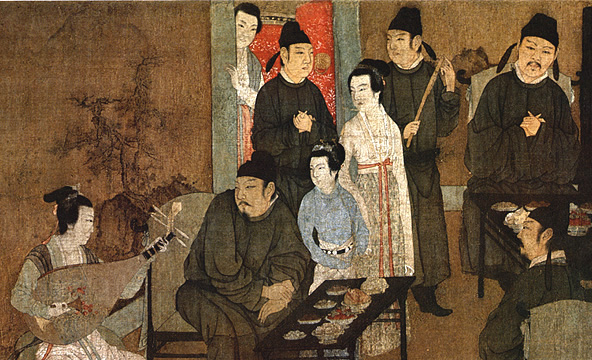
| SOURCE:
Zhongguo lidai huihua: Gugong bowuyuan canghua ji,
vol. 1 ( Beijing: Renmin meishu chubanshe, 1978), p. 87.
Collection of the National Palace Museum, Beijing.
Detail of handscroll (pipa player against standing
screen), ink & colors on silk, 28.7 x 335.5 cm |
| SOME
COMMENTS: The Night Revels of Minister Han Xizai
is believed to have originally been painted by the
Southern Tang artist Gu Hongzhong for the emperor Li Yu
of that dynasty. Its purpose was to admonish one
of the leading ministers, Han Xizai, who, though
an able official, was nevertheless recalcitrant in his
duties, failing to appear on several occasions for his
early morning audiences with the emperor. It got
to be common knowledge that this was due to an excess of
revelry with singsong girls and banquets held in his own
private apartments. The emperor, seeking to shame
the wayward minister into exhibiting greater decorum,
assigned a painter to attend the night-long parties as a
secret informant, and to afterwards recreate on silk the
untoward behavior he had witnessed among the officials
present. It is said that Minister Han Xizai, after
being confronted with his misdeeds recorded in detail in
the painting, disregarded this tactful reprimand and
continued his escapades up until the fall of the
Southern Tang to Song forces. |
|
|
In the details below and elsewhere on this page, how would
you characterize the differences in physical demeanor of men and
women as they communicate with others? Do the men have a
more uniform appearance throughout the painting, and what might
account for this?
|
|

SOURCE:
Zhongguo
lidai huihua: Gugong bowuyuan canghua ji,
vol. 1 (Beijing: Renmin meishu chubanshe, 1978), p. 90.
Collection of the National Palace Museum, Beijing.
Detail of handscroll (hand washing scene), ink &
colors on silk, 28.7 x 335.5 cm |
|
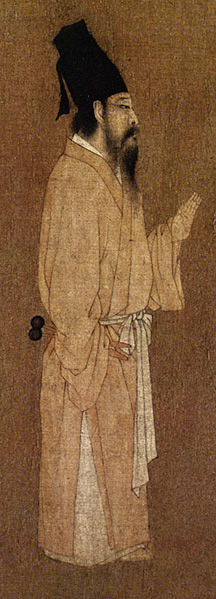
SOURCE:
Zhongguo
lidai huihua: Gugong bowuyuan canghua ji,
vol. 1 (Beijing: Renmin meishu chubanshe, 1978), p. 93.
Detail of handscroll (Minister in final scene), ink and
colors on silk, 28.7 x 335.5 cm |
|
| Is there a difference in
appearance among individual women in the painting? Do the
musicians below seem to have a different mode of dress or
hairstyle than other female companions? |
 |
SOURCE:
Zhongguo lidai huihua: Gugong bowuyuan canghua ji,
vol. 1 (Beijing: Renmin meishu chubanshe, 1978), p. 91.
Collection of the National Palace Museum, Beijing.
Detail of handscroll (women musicians), ink & colors
on silk, 28.7 x 335.5 cm |
|
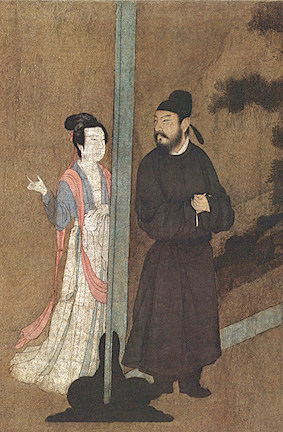 |
Does the setting in this scene imply
anything about the type of interaction or what might be
communicated between these individuals?
| SOURCE: Zhongguo
lidai huihua: Gugong bowuyuan canghua ji,
vol. 1 (Beijing: Renmin meishu chubanshe, 1978), p. 92. Detail of handscroll (man and woman talking with standing screen
between them), ink and colors on silk, 28.7 x 335.5 cm |
|
|
| Judging from manner of dress and
level of participation in the activity depicted below, what
differences can you discern in social status among the men in
this scene? |
|
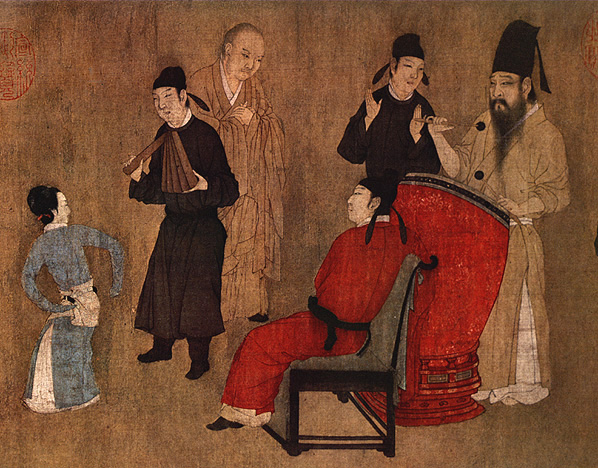
| SOURCE:
Zhongguo
lidai huihua: Gugong bowuyuan canghua ji,
vol. 1 (Beijing: Renmin meishu chubanshe, 1978), p. 88.
Detail of handscroll (dancing scene), ink and colors on
silk, 28.7 x 335.5 cm |
|
| Compare the female figures in the
details below. What do their postures and body language
communicate about their attitude toward their surroundings or
the people they are interacting with? |

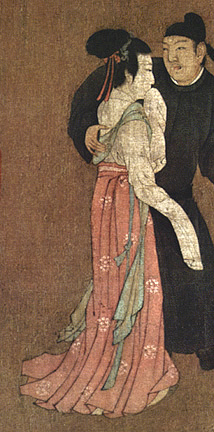
| SOURCE:
Zhongguo
lidai huihua: Gugong bowuyuan canghua ji,
vol. 1 (Beijing: Renmin meishu chubanshe, 1978), p. 93.
Detail of handscroll (final scene), ink and colors on
silk, 28.7 x 335.5 cm |
Zhongguo
lidai huihua: Gugong bowuyuan canghua ji,
vol. 1 (Beijing: Renmin meishu chubanshe, 1978), p. 93.
Detail of handscroll (final scene), ink and colors on
silk, 28.7 x 335.5 cm
|
|
|




